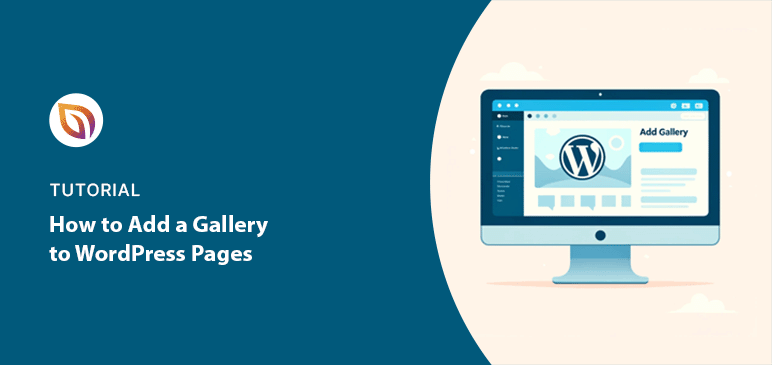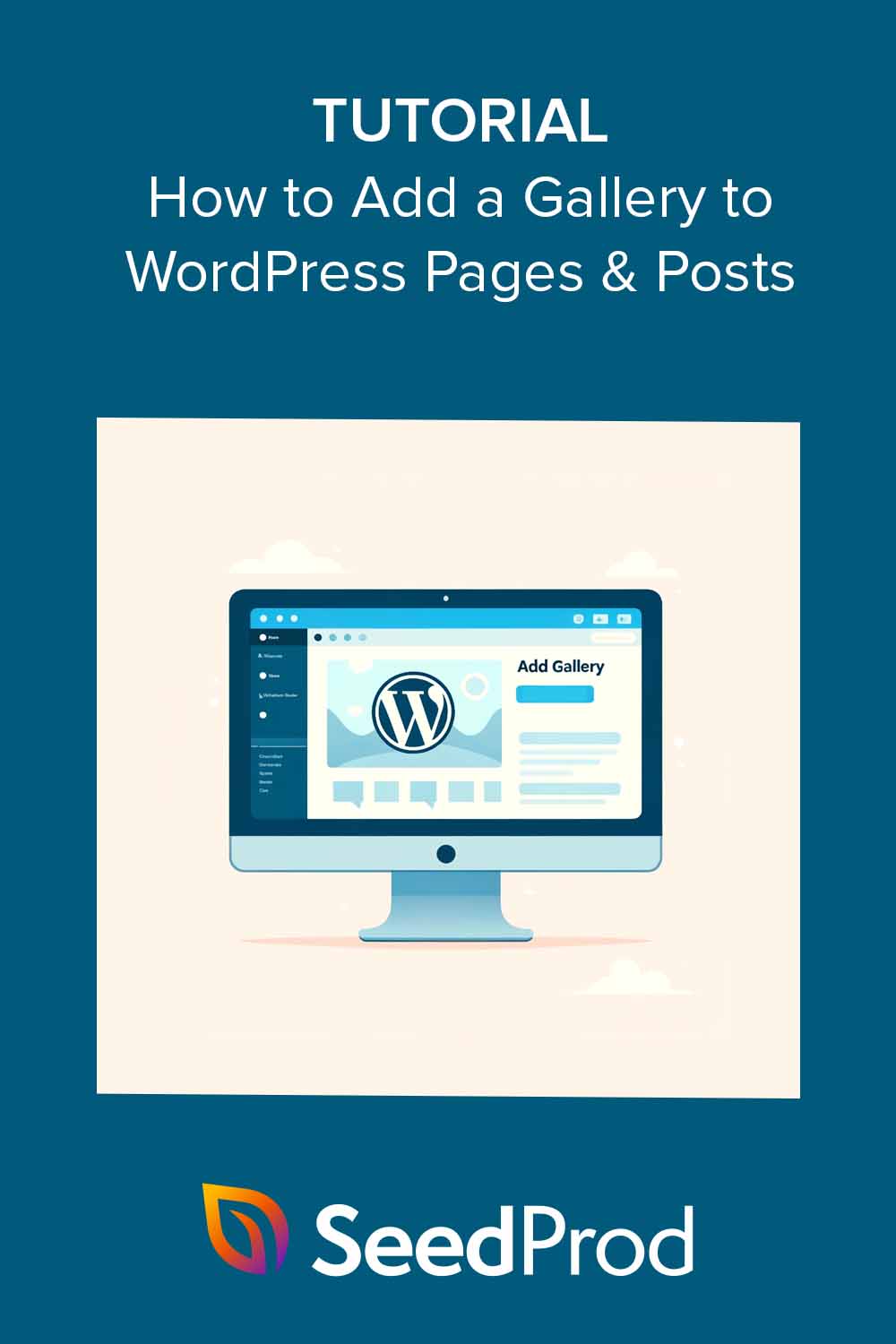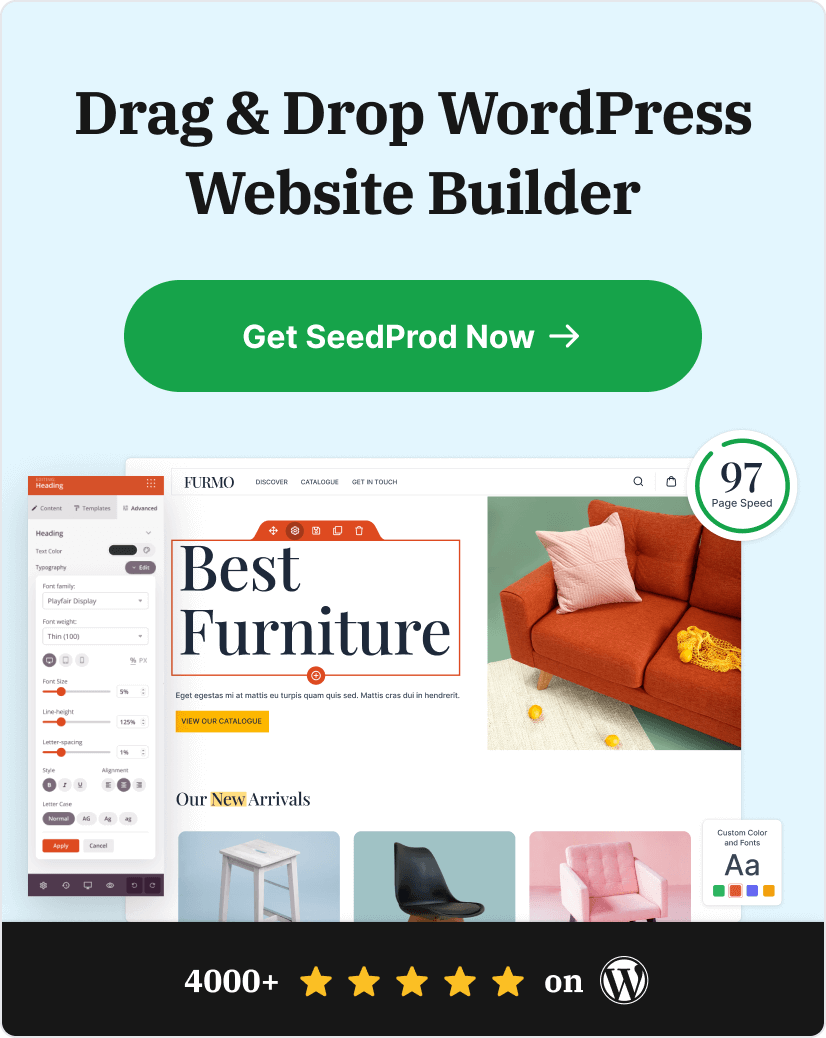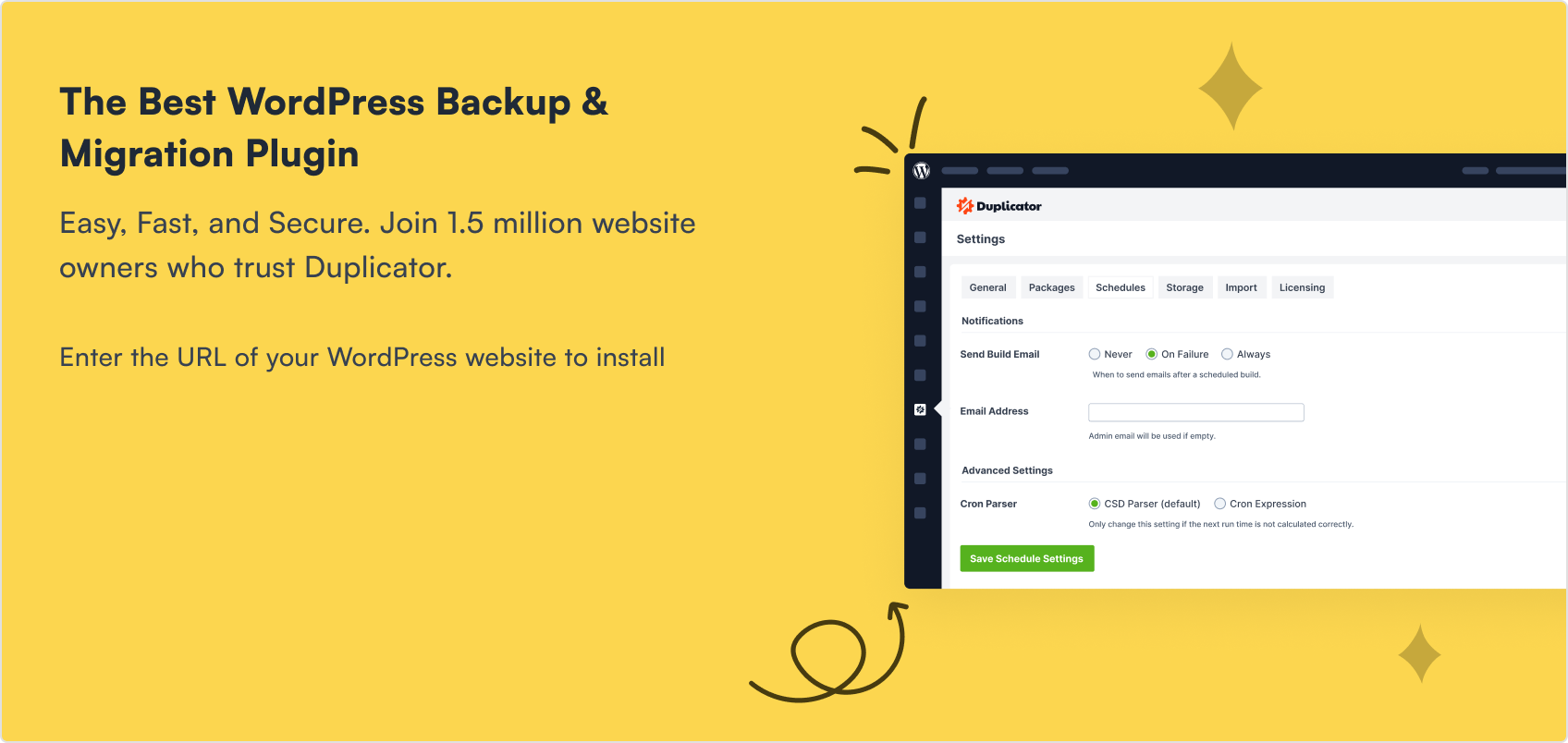You can add a gallery to WordPress pages and posts in just a few minutes. Whether you’re sharing photos, artwork, or products, a gallery makes your site look more professional and keeps visitors engaged.
I’ve built galleries in WordPress using blocks, plugins, and page builders. Each method works a little differently, so in this guide I’ll walk you through the 3 best options step by step, with tips to make your galleries load fast and look great.
- Why Add a Gallery to WordPress?
- Options for Adding Galleries to WordPress
- How to Add a Gallery to WordPress with a Page Builder
- How to Create an Image Gallery with a Plugin
- How to Add a Gallery to WordPress Without a Plugin
- Image Optimization for WordPress Galleries
- FAQs on Adding a Gallery to WordPress
Why Add a Gallery to WordPress?
A WordPress gallery organizes your photos in a clean, clickable layout that’s easier to browse than single images stacked on a page.
Here are the main reasons to add a gallery instead of inserting images one by one:
- Better user experience: Visitors can scan multiple images quickly without endless scrolling.
- Professional look: Galleries add structure and polish to portfolios, blogs, and product pages.
- SEO benefits: Optimized galleries can drive traffic from Google Images and improve engagement signals.
- Interactive features: With the right tools, you can add lightbox popups, filters, and carousels.
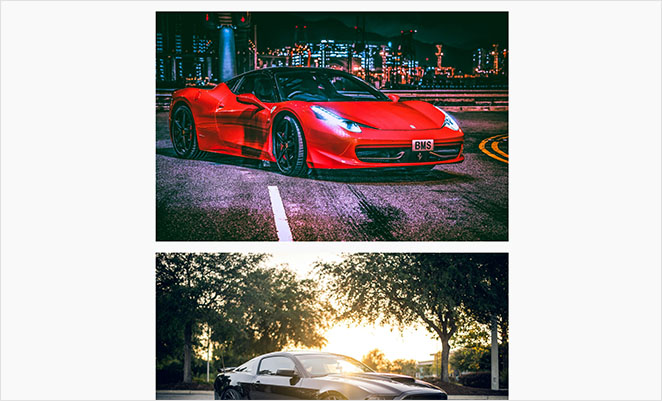
I use galleries whenever I need to showcase multiple visuals on one page. It keeps the design neat and makes the content more engaging.
Options for Adding Galleries to WordPress
There are several ways to add a gallery to WordPress pages and posts. The most straightforward is to use the built-in WordPress Gallery block.
It’s a good solution for a beginner because it’s easy to use. However, you have little control over its appearance beyond image size and captions. So, I wouldn’t recommend it for sites that need more customization options.
You can also use WordPress image gallery plugins. They come with many more customization options and advanced features. For example, the most popular gallery plugins offer:
- Lightbox popups
- Unique layouts
- Animations and hover effects
- Image protection (watermarking)
- And more.
Alternatively, many WordPress page builders have unique image gallery modules. They make adding galleries to your landing pages easy without installing extra plugins.
Don’t worry if you can’t choose just yet. I’ll cover all three options in the tutorial below so you can find one that best suits your needs.
Tip: If you want the most design control on a single page (like a portfolio or product showcase), use SeedProd. If you need galleries across many posts, use a gallery plugin. For something quick and simple, use the built‑in Gallery block.
I’ll kick things off with my favorite method, adding a gallery to WordPress using a page builder.
| Method | Works in Pages | Works in Posts | Customization | Best For | Notes |
|---|---|---|---|---|---|
| SeedProd Page Builder | ✅ | ❌ | High (grid, filters, carousel) | Portfolios, landing pages | Add galleries inside high‑converting layouts; visual control. |
| Envira Gallery Plugin | ✅ | ✅ | High (lightbox, watermark, captions) | Bloggers, shops, galleries across posts | Feature‑rich; works site‑wide without a page builder. |
| WordPress Gallery Block | ✅ | ✅ | Basic (columns, captions, simple styles) | Simple needs, minimal plugins | Fast, built‑in option; fewer layout effects. |
How to Add a Gallery to WordPress with a Page Builder
When you’re creating a high-converting gallery page, like a portfolio, you want tools that make generating leads and conversions easier.
You could create a landing page in the WordPress editor and use the Gallery block. However, it likely won’t have the other features you need, like:
- Countdown timers
- Testimonials
- Opt-in forms
- Pricing tables
- Star ratings
In this case, using a WordPress page builder with everything you need in a single WordPress plugin makes more sense.
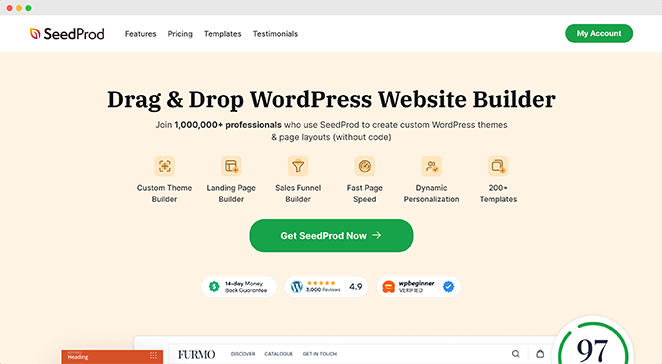
My top choice is SeedProd, one of the best drag-and-drop WordPress page builders. With it, you can create landing pages that convert and display your work with its advanced gallery block.
First, you’ll need to install and activate the SeedProd plugin on your WordPress site. If you need help with this, please see our guide on how to install SeedProd Pro.
After activating the plugin, go to SeedProd » Landing Pages from your WordPress dashboard, and click the “Add New Landing Page” button.
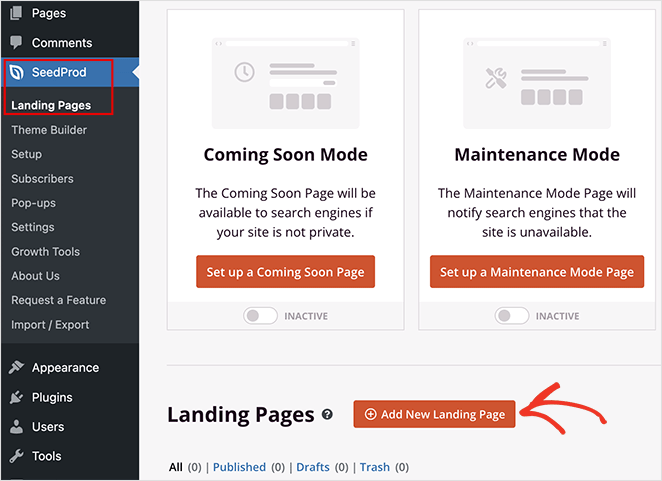
Now, browse the landing page templates to find a pre-made design that suits your needs. You can also start from scratch with a blank page template.
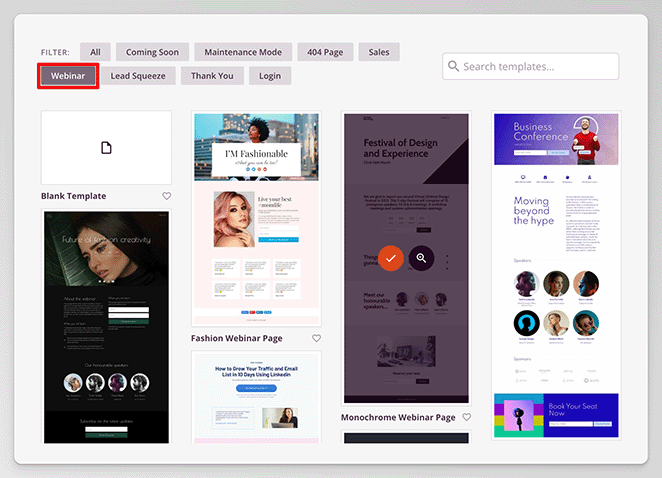
Simply hover over a template and click the checkmark icon to launch it in SeedProd’s drag-and-drop builder. Then, you can customize the page visually to make it your own.
For more detailed steps, please see my step-by-step guide on how to create a landing page in WordPress.
Note: With SeedProd, you can only add galleries to WordPress pages; not posts.
Adding a Gallery to Your WordPress Landing Page
After setting up your landing page, you’ll want to customize it with a WordPress photo gallery. There are 3 ways to do this in SeedProd:
- Gallery Block: A simple multi-column gallery.
- Advanced Gallery Block: A single or multiple gallery with filters, overlays, and text descriptions.
- Image Carousel Block: A single-column sliding image gallery with autoplay options.
Using the Gallery Block
To add the Gallery block, find it in the blocks sidebar on the left and drag it into place on your page.
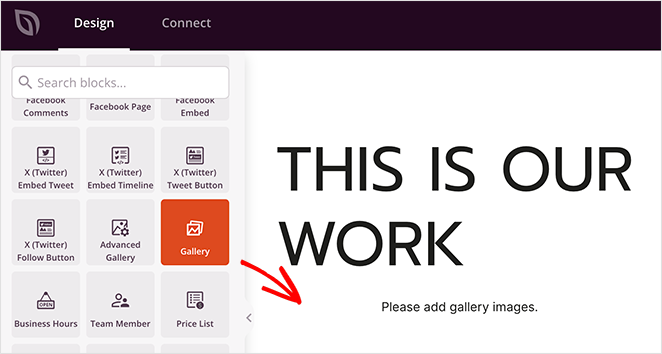
Then click the “Add Gallery Images” option in the block settings.
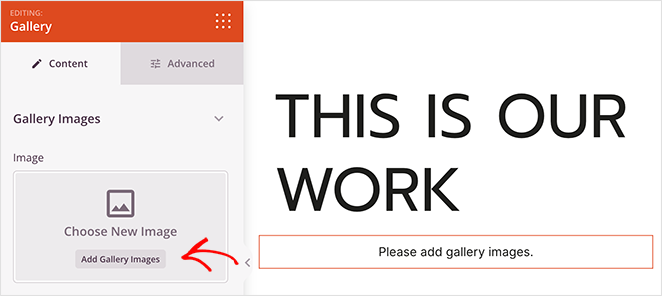
Now, you can upload new images from your computer or select images from your WordPress media library. Select all the images you want to add to your gallery, then click “Create Gallery.”

You can then give each image a caption and click the “insert Gallery” button.
You’ll now see the gallery on your landing page. From there, click the “Settings” tab in the block options to adjust the gallery columns, link, image size, and order.
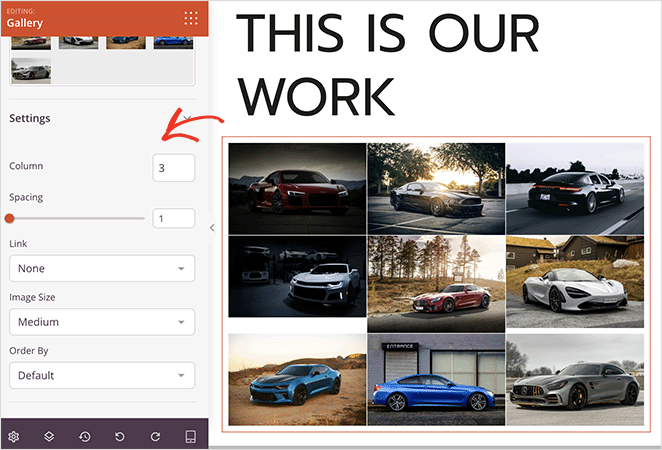
Using the Advanced Gallery Block
The Advanced Gallery block works similarly. However, instead of a single gallery, you can add multiple galleries and display filters for users to easily choose what they want to see.
As before, find the Advanced Gallery block in the left-hand sidebar and drag it onto your page.
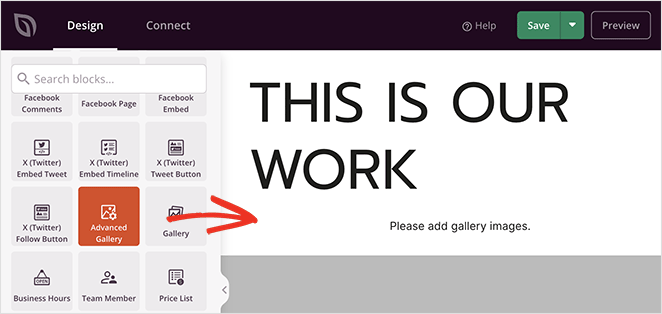
This time, there’s a dropdown menu to choose “single” or “multiple.” I’ll select multiple to show you how it works.
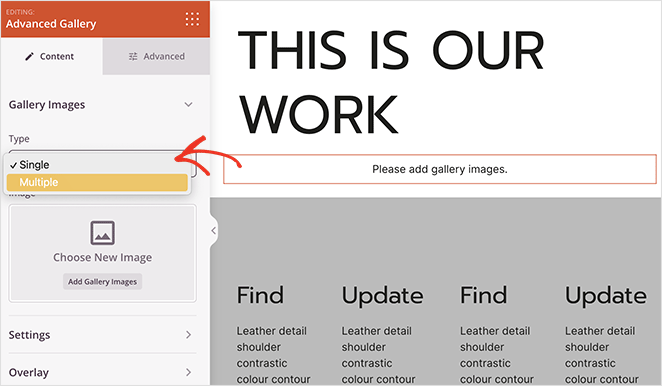
As you can see, choosing that gives you a “tab” option. This is your first gallery.
Click the tab to expand it and see the gallery settings.
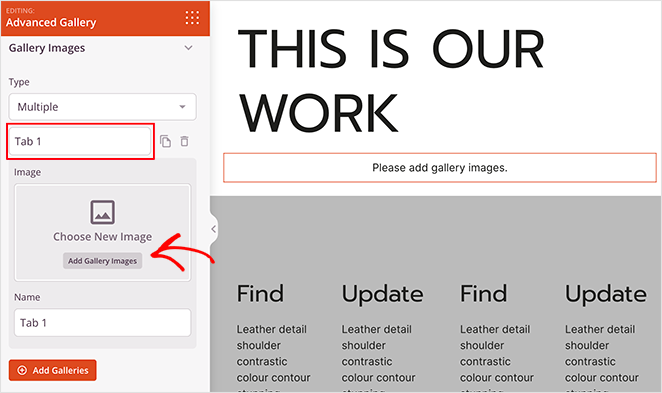
Here, click the “Add Gallery Images” option and follow the steps like before to add media and insert your photos.
Now, click the “Add Galleries” button to add another image gallery.
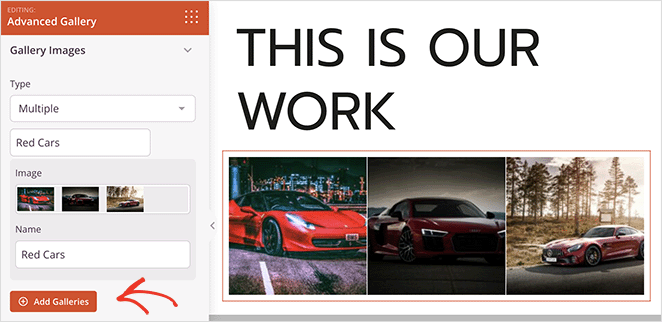
On the gallery preview, you’ll see several headings. In my example, they’re “All,” “Red Cars,” and “Black Cars.”
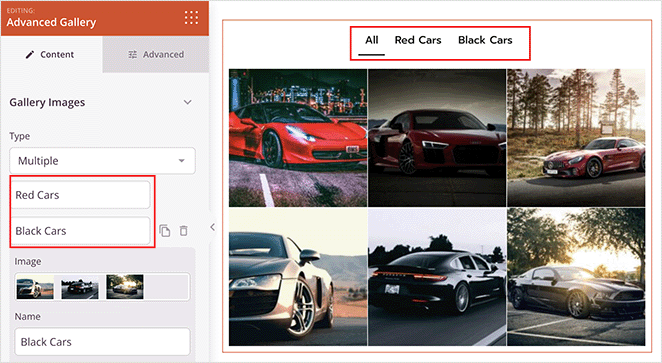
This means users can view all images at once or one gallery at a time.
In this block, there’s an extra setting called “Overlay”. Expand it, and you can enable the overlay effect. This effect let’s you add a color overlay to the gallery image thumbnails that show when you hover over it.
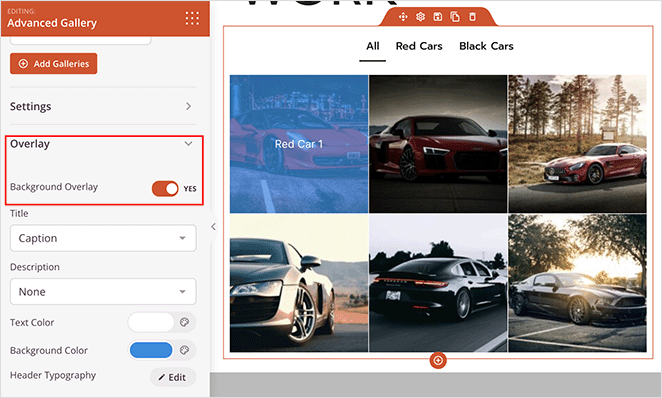
You can also display the image caption, title, or description to give visitors more context.
Using the Image Carousel Block
If you want your images to take up less room on the page, use the Image Carousel block.
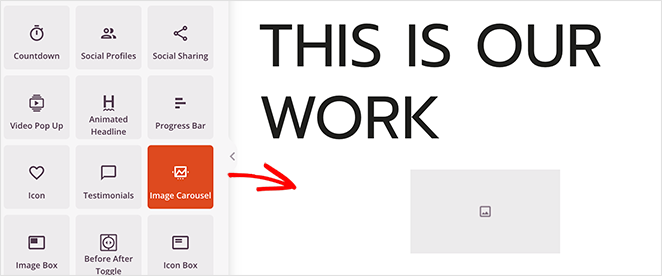
In the block settings, you can upload images individually, but instead of a grid, they’ll appear as a slideshow with pagination.
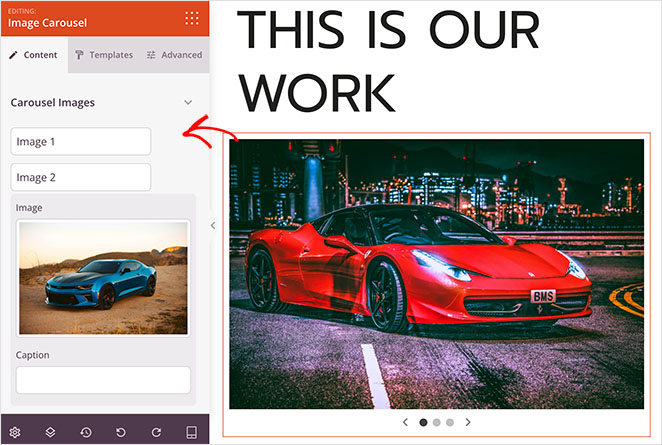
Users can manually click to slide through each image, or you can set the carousel to autoplay in the settings area.
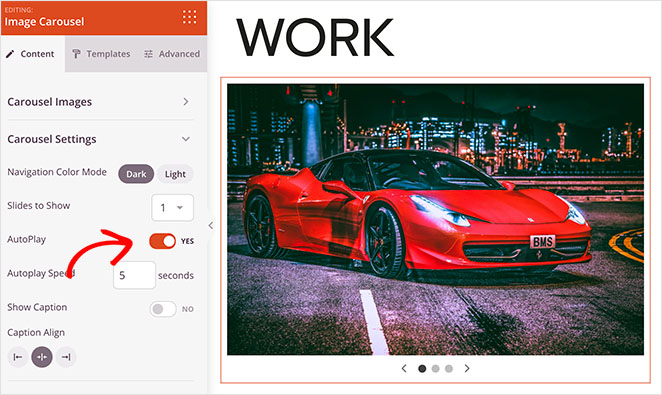
Choose the method that works best for you. And don’t forget to click “Save” and “Publish” to make the changes live on your website.
How to Create an Image Gallery with a Plugin
Now, I’ll walk you through an alternative: a WordPress gallery plugin. This method is ideal if you want image galleries with plenty of features to add to pages and posts.
For this, I recommend Envira Gallery, one of the best photo gallery plugins for WordPress.
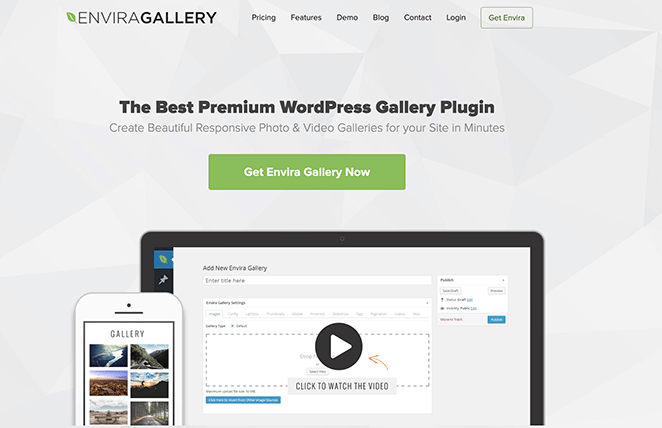
Its drag-and-drop functionality makes it easy to use, and has all the features you need to build a responsive, user-friendly gallery layout.
First, you’ll need to install and activate the Envira Gallery plugin. I’m using the free version for this example, but the Pro version unlocks many more addons, like watermarking, password protection, social media icons, WooCommerce galleries for eCommerce sites, and more.
For help, please see this handy guide on how to install a WordPress plugin.
Adding Envira Gallery to a WordPress Page
Upon activation, create a new page or edit an existing one. Then, click the plus icon to add a new WordPress block, search for “Envira,” and click to add it to your page.
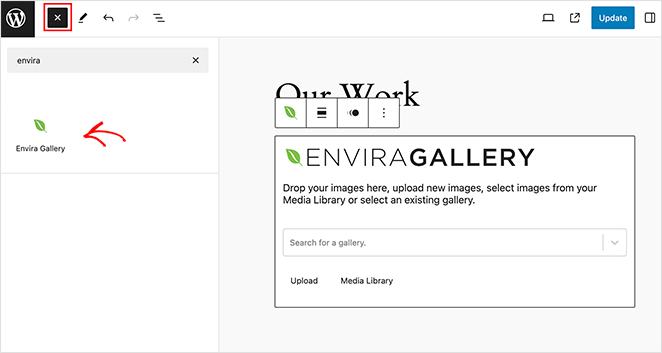
Next, click the “Media Library” button to choose images from your library to add to the gallery.
To edit your gallery, click the “Edit Gallery” option in the toolbar or the right-hand sidebar.
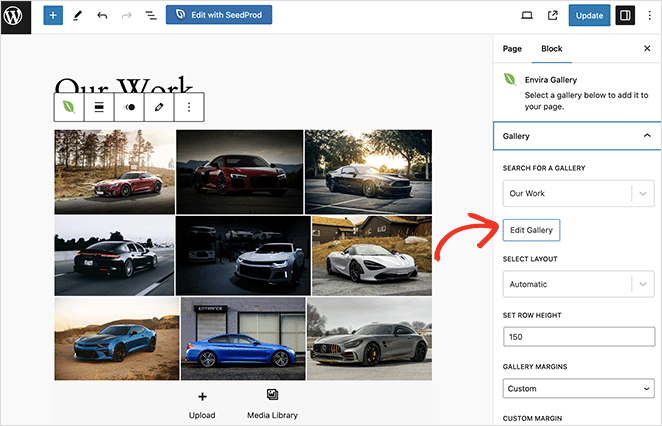
This opens a new tab with various customization options.
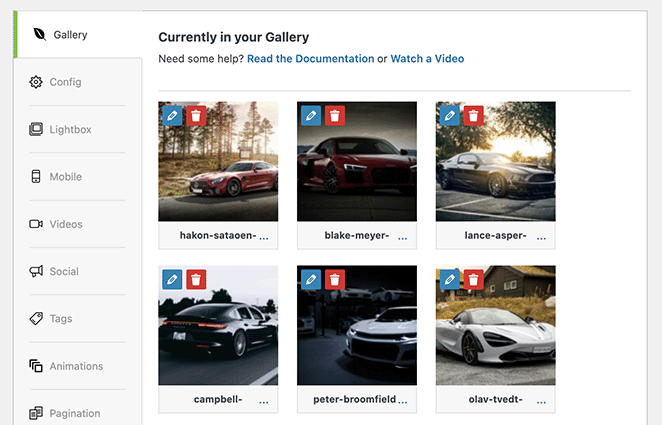
For example, in the “Config” tab, you can set the number of columns, turn lazy loading on or off, set the automatic row height and margins, and choose the image size and dimensions.
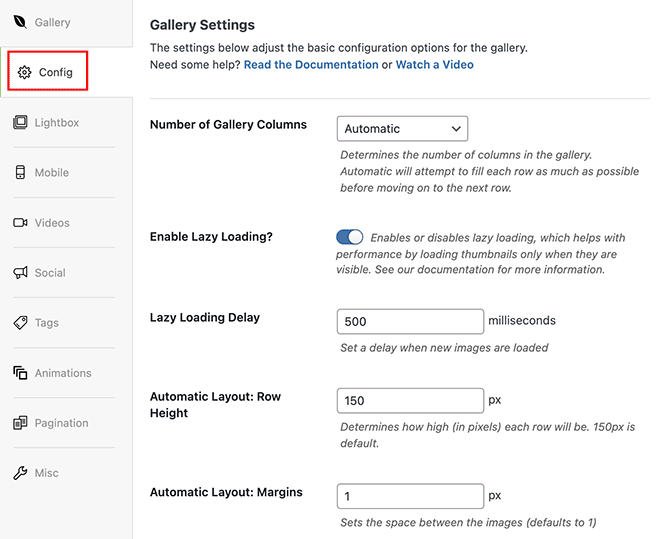
You can also click the “Lightbox” tab to enable a gallery lightbox effect that opens your images in full size when users click them.
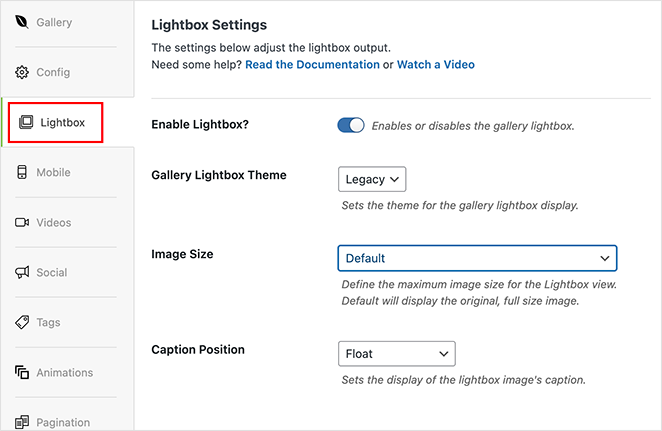
When you’re happy with your settings, click “Update” in the top-right corner, then return your page. From there, save and publish your page to show the gallery live on your website.
You can also use this method to add a gallery to WordPress posts.
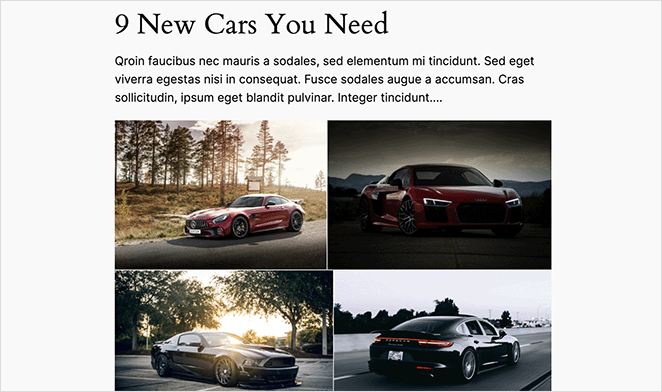
How to Add a Gallery to WordPress Without a Plugin
If you prefer a website with minimal WordPress plugins or need something simple without the bells and whistles, the built-in WordPress Gallery block is a solid choice.
To use it, edit or create a new page or post, click the plus icon to add a block in the block editor (Gutenberg), and look for the Gallery block.
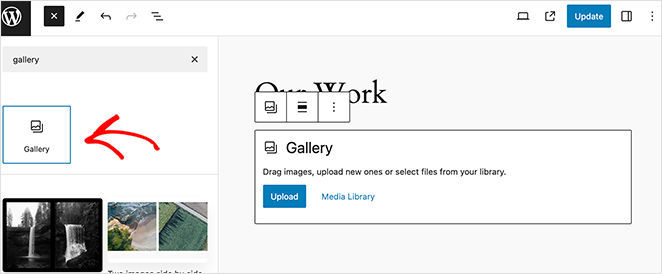
Next, upload your images or choose them from the WordPress media library and click the “Create New Gallery” button.
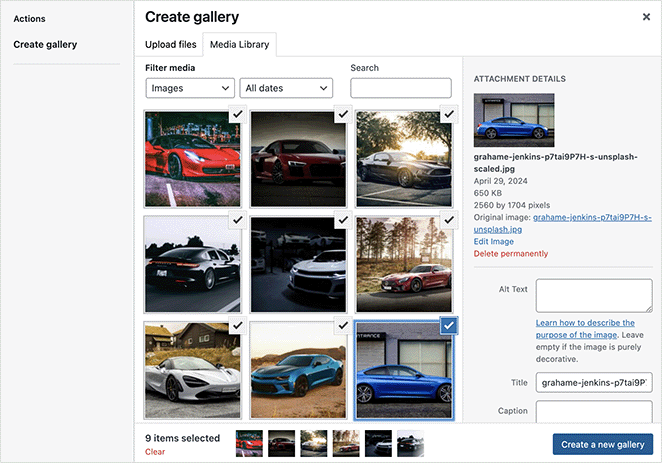
Then, add captions or rearrange your gallery, and select the “Insert Gallery” button.
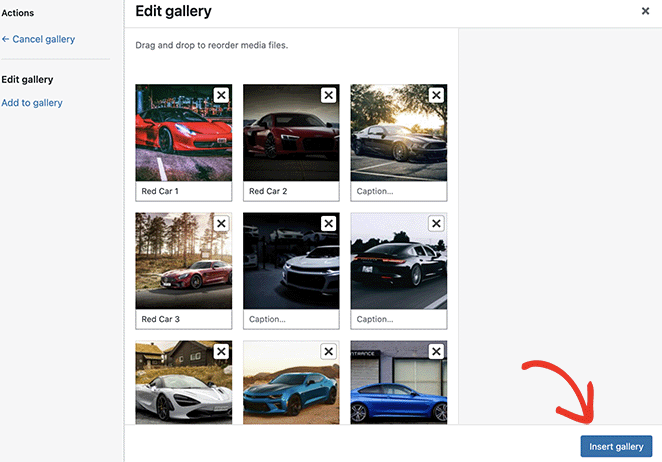
Once it’s in your post or page, you can customize the gallery by choosing options in the right-hand sidebar.
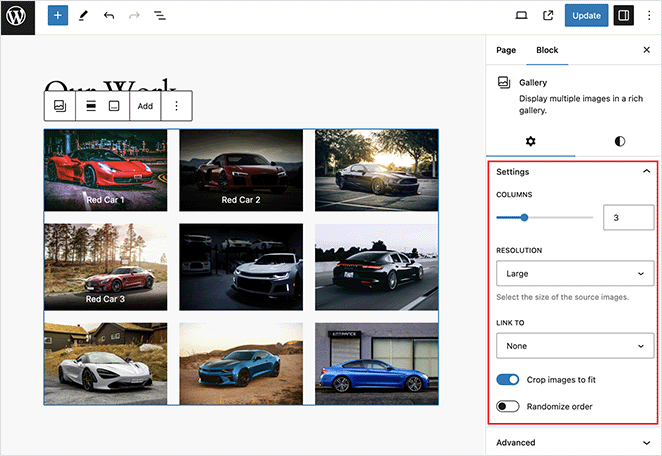
For instance, you can set the number of columns and resolution, link to the media file or attachment page, and crop images to fit.
Switching to the “Styles” settings allows you to set a custom background color and adjust the spacing between images.
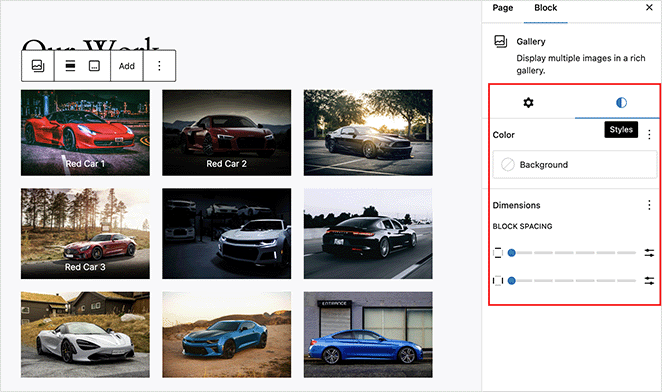
When you’re happy with the changes, click update or publish to make them live.
Image Optimization for WordPress Galleries
Optimizing your gallery images is just as important as adding them. Large, uncompressed files can slow down your site and hurt SEO. I always optimize before uploading so my galleries look sharp without dragging down page speed.
Here are the key steps I recommend:
- Resize images: Match the size you need on your site. Don’t upload a 3000px image if it only displays at 800px wide.
- Compress files: Use tools like TinyPNG, ShortPixel, or Imagify to reduce file size without losing quality.
- Use the right format: JPEG for photos, PNG for transparency, and WebP for modern performance and SEO benefits.
- Add descriptive alt text: This helps with accessibility and can drive traffic from Google Images.
- Lazy load galleries: WordPress has this built in now. It ensures images load as visitors scroll, improving speed.
I’ve seen galleries go from slow and clunky to fast-loading just by resizing and compressing images first. It makes a huge difference for visitors and rankings.
FAQs on Adding a Gallery to WordPress
Create Your Next Image Gallery
I hope the methods in this guide have helped you learn how to add a gallery to WordPress. Pick one that works for you, then bring your website to life with engaging visual content.
You might also like the following WordPress tutorials on using images:
- How to Use AI to Generate Images on Your WordPress Website
- How to Add a Featured Image to WordPress
- How to Add Hotspot Images to WordPress
- How to Add Text on an Image in WordPress
- How to Dim a Background Image in WordPress Without CSS
Thanks for reading! We’d love to hear your thoughts, so please feel free to join the conversation on YouTube, X and Facebook for more helpful advice and content to grow your business.

